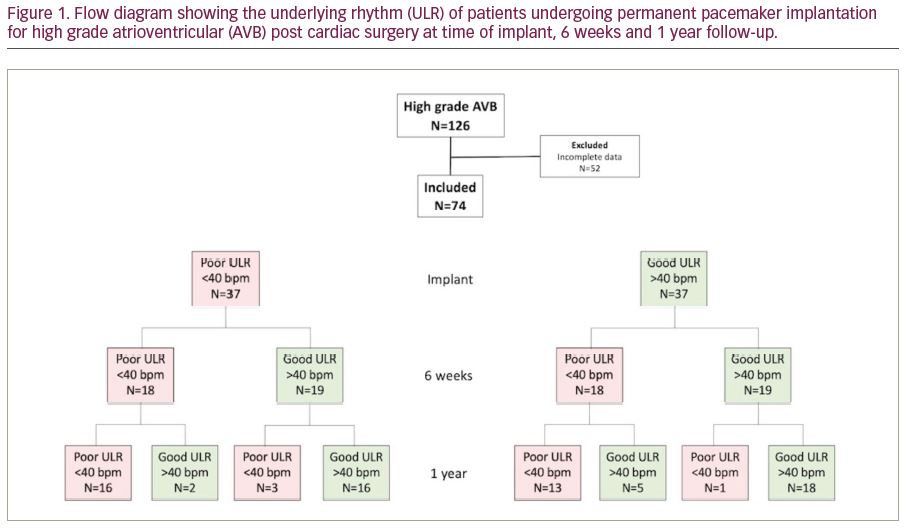Introduction: Conduction tissue damage during cardiac surgery necessitates permanent pacemaker (PPM) implantation in approximately 4% of patients. Studies have demonstrated late recovery of conduction in 16-42% of patients, but the time course is unknown. It is also unclear whether the presence of an underlying rhythm (ULR) at the time of implant predicts late recovery. We sought to assess the ULR at implant, 6 weeks and 1 year in patients undergoing cardiac device implantation post cardiac surgery and whether ULR at implant and 6 weeks was predictive of late conduction recovery.
Methods: 193 consecutive patients underwent cardiac device implantation post cardiac surgery between August 2015 – December 2018 at Liverpool Heart & Chest Hospital. Data were extracted from hospital administrative records and electronic medical records. The presence of an ULR was recorded at implant, 6 weeks and 1 year follow-up (>40 bpm = good ULR, below 40 bpm = poor ULR). Only patients with high grade atrioventricular block (AVB, defined as complete or second degree non-Mobitz type 1) and complete follow-up data were included. Sensitivity and specificity of ULR at implant and 6 weeks for predicting poor ULR at 1 year were determined. Group differences (good ULR vs poor ULR at 1 year) were assessed using Chi-squared or Mann Whitney tests. P<0.05 was statistically significant.
Results: 74 patients were included (median age 72 years, 62% male, 93% PPM). Reasons for exclusion included non-AVB (n=67) and incomplete data (n=52). Surgery included aortic valve replacement (n=45 [61%]), mitral valve repair or replacement (n=21 [28%]), combined aortic and mitral valve (n=7 [10%]) and coronary artery bypass graft (n=28 [38%], non-exclusive). Median time to implant from surgery was 5 days (lower quartile 7, upper quartile 9). Figure 1 demonstrates ULR at implant, 6 weeks and 1 year. ULR at 6 weeks was predictive of ULR at 1 year (sensitivity 100%, specificity 89%), whilst ULR at implant was not (sensitivity 33%, specificity 70%). Aortic valve surgery (p=0.001) was significantly associated with poor ULR at 1 year, however age, gender, pre-operative conduction disease and rate limiting medications were not.
Conclusion: The present data suggests that conduction recovery (when present) predominantly occurs early post cardiac surgery. In our cohort of patients, the ULR at 6 weeks post implant was more predictive of late conduction recovery, compared to the ULR at time of implant. Future study is warranted to assess whether programming interventions at 6 weeks may help reduce ventricular pacing requirements in patients with signs of early conduction recovery.








